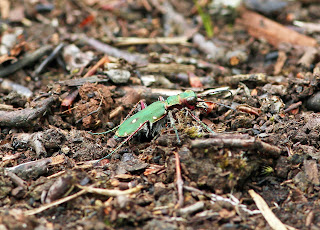Birdwise,today was pretty good for the time of year considering most species are either busy feeding chicks in the nest or fledging them.Best of the bunch went to a 2nd calendar year Hobby which showed brilliantly near to the duck hide as it hawked my beloved dragonflies,later being observed perched in a Silver Birch near the wader hide.This species seems to be a regular feature in the area,with immatures summering most years a very welcome sight.
Other bird sightings consisted of 2 Green Sandpiper and 6 Little Egret feeding around the bottom islands on the main lake,but there was no sign of the previous days Great-white Egret which had travelled over the river to North Cave Wetlands.
Today's visit produced 2 new species for me from the world of insects,in the form of the stunning Blue Shieldbug,my first records for the reserve and a totally new Ladybird for me in the form of a Ten-spot Ladybird.The Blue Bugs included 3 stunning,bright red final instars and a single beautiful metallic adult and were found along the path to the wader hide and the Ladybird was seen along the footpath just past the turning to the wader hide on a Willow,fantastic stuff!.
Lepidoptera were very well represented on the visit today,with the main highlight being a cracking Red-tipped Clearwing seen along the edge of the path from the duck hide towards the turning to the wader hide.This is the second time i have observed this diminutive little moth on the reserve and goes to show,you don't always have to use pheromones to see them.Other moths recorded today included Shaded-broad Bar,Yellow Shell and Silver Y.
Butterflies were also seen in a good variety,with 15 species recorded and the best of these included 4 Red Admiral and a single Essex Skipper,with welcome second broods of Peacock,Comma,Speckled Wood,Brimstone,Green-veined and Large White on the wing.
Another family of insects i try and take an interest in are Syrphidae or Hoverflies as they are more commonly known and i found a cracker today in the form of a female Chrysotoxum bicinctum.This species is one of which i do not encounter very often here and has an interesting breeding biology where the larvae feed on aphids in ants nests.
Other species observed included Eristalis intricarius,Helophilus pendulus,Episyrphus balteatus,Eupeodes corollae and Volucella pelluscens.
Other assorted insect species seen included at least 5 Oxycera rara,a stunning little soldier fly which is found on the reserve.
A couple of Common Lizards were also observed today in the usual spots and gave the usual fantastic views,they must be well used to cameras pointing at them by now!.
Finally how could i end this post without mentioning the fantastic profusion of wild flowers on show,the obvious highlight from a rarity point of view were the few spikes of Dune Helleborines on show this year,but the commoner species really were impressive and included the stunning Marsh Thistles,Giant Bellflower,Evening Primrose and a personal fave Purple Loosestrife to name but a few.
So what an amazing visit today and along with me finding the male Lesser Emperor as well,well words fail me to what a brilliant place this is,but i've always known that and i certainly look forward to my next visit to this cracking reserve.
 |
| Soldier Fly - Oxycera rara. |
 |
| Hoverfly - Chrysotoxum bicinctum. |
 |
| Incoming...Comma with Hoverfly,Episyrphus balteatus for company. |
 |
| Gatekeeper. |
 |
| Hoverfly - Eristalis intricarius. |
 |
| Queen Tree Bumblebee. |
 |
| Red-tipped Clearwing....stunning!. |
 |
| Common Lizard. |
 |
| Final instar Blue Shieldbug. |
 |
| Adult Blue Shieldbug. |
 |
| Dune Helleborine. |
 |
| Female Common-green Grasshopper. |
 |
| Record shot of the Ten-spot Ladybird. |








